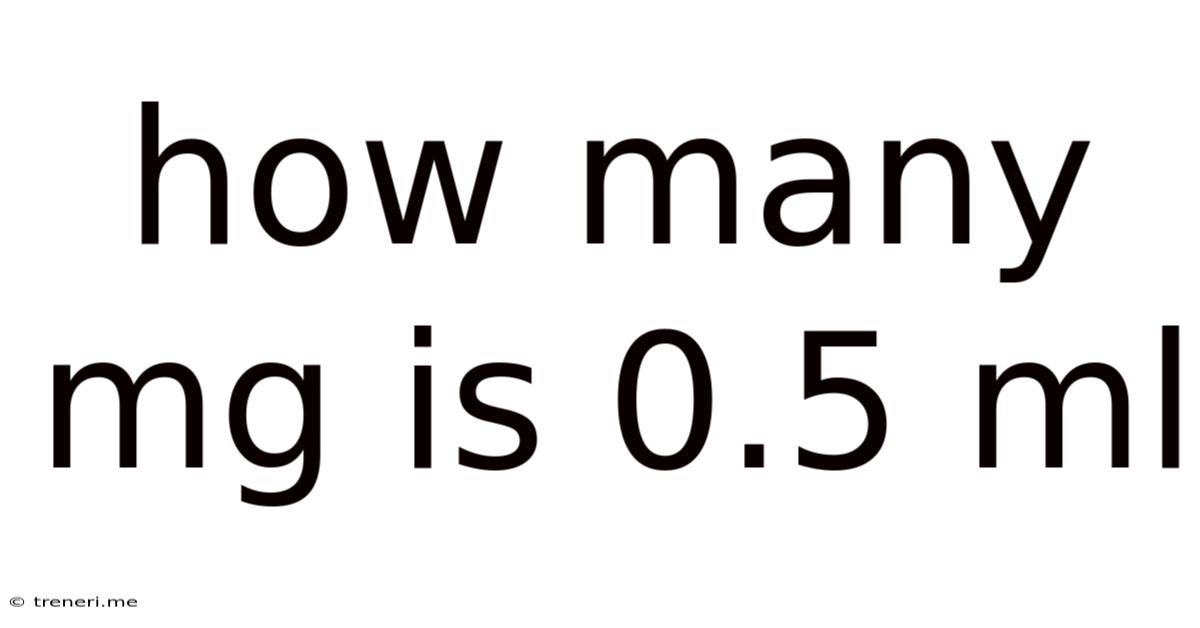How Many Mg Is 0.5 Ml
Treneri
Apr 10, 2025 · 4 min read

Table of Contents
How Many mg is 0.5 ml? A Comprehensive Guide to Conversions and Considerations
Understanding the relationship between milligrams (mg) and milliliters (ml) is crucial in various fields, from medicine and pharmaceuticals to cooking and chemistry. This seemingly simple conversion, however, isn't straightforward and requires careful consideration of the substance involved. The key takeaway is: you cannot directly convert mg to ml without knowing the density of the substance. This article will delve deep into this concept, explaining why a direct conversion is impossible and offering practical guidance for different scenarios.
The Importance of Density
The core issue lies in the fundamental difference between milligrams and milliliters. Milligrams (mg) measure mass – the amount of matter in a substance. Milliliters (ml) measure volume – the amount of space a substance occupies. The connection between the two is density, which is defined as mass per unit volume.
The formula is: Density = Mass / Volume
Therefore, to convert between mg and ml, you need to know the density of the specific substance you're working with. The density is usually expressed in grams per milliliter (g/ml) or milligrams per milliliter (mg/ml).
Converting mg to ml: A Step-by-Step Guide
Let's break down the conversion process, assuming you have the density of the substance.
1. Determine the Density: This is the most crucial step. The density of water, for instance, is approximately 1 g/ml (or 1000 mg/ml). However, the density of other substances, such as oil, alcohol, or medications, will vary significantly. You'll usually find this information on the product label, a material safety data sheet (MSDS), or a scientific database.
2. Convert mg to g (if necessary): If your mass is given in milligrams (mg), convert it to grams (g) by dividing by 1000. This step ensures consistent units in the density calculation.
3. Apply the Density Formula: Rearrange the density formula to solve for volume:
Volume (ml) = Mass (g) / Density (g/ml)
4. Calculate the Volume: Substitute the values you've obtained into the formula to calculate the volume in milliliters.
Examples:
Let's illustrate this with some examples:
Example 1: Water
Let's say you have 500 mg of water. The density of water is approximately 1 g/ml.
- Step 1: Density = 1 g/ml
- Step 2: Mass (g) = 500 mg / 1000 mg/g = 0.5 g
- Step 3: Volume (ml) = 0.5 g / 1 g/ml = 0.5 ml
Therefore, 500 mg of water occupies a volume of 0.5 ml.
Example 2: A Medication
Imagine you have a medication with a density of 1.2 g/ml and you need to convert 750 mg to ml.
- Step 1: Density = 1.2 g/ml
- Step 2: Mass (g) = 750 mg / 1000 mg/g = 0.75 g
- Step 3: Volume (ml) = 0.75 g / 1.2 g/ml ≈ 0.625 ml
Therefore, 750 mg of this medication occupies approximately 0.625 ml.
The Specific Case of 0.5 ml: Why It's Insufficient Information
The question "How many mg is 0.5 ml?" is inherently unanswerable without specifying the substance. 0.5 ml represents a volume, not a mass. A 0.5 ml volume of water will have a different mass (and therefore a different number of milligrams) than 0.5 ml of oil or mercury.
The critical missing piece is the density.
Common Misconceptions and Pitfalls
Several misconceptions surround mg to ml conversions:
-
Assuming a 1:1 ratio: Many mistakenly believe that 1 mg always equals 1 ml. This is incorrect except in the specific case of substances with a density of 1 g/ml, like pure water at standard temperature and pressure.
-
Ignoring density variations: Density changes with temperature, pressure, and the chemical composition of the substance. Failing to account for these variations leads to inaccurate conversions.
-
Mixing units: Inconsistent units are a common source of error. Ensure that all your units (mg, g, ml) are consistent before performing calculations.
Applications in Different Fields
Understanding mg to ml conversions is important in various fields:
-
Pharmaceuticals: Accurate dosage calculations depend heavily on density and volume conversions. Incorrect conversions can have serious health consequences.
-
Chemistry: Density is a fundamental property in chemistry, used extensively in stoichiometric calculations and experimental procedures.
-
Cooking: While less critical than in medicine, understanding density can help in baking and cooking where ingredient ratios and volumes matter.
-
Industrial processes: Many industrial processes involve handling substances with varying densities; accurate volume-to-mass conversions are crucial for efficiency and safety.
Conclusion
Converting milligrams to milliliters or vice versa is not a simple matter of direct substitution. The density of the substance is absolutely crucial for accurate conversion. Always ensure you know the density of the material before attempting any conversion. Failing to do so could lead to errors with significant implications depending on the application. Remember to meticulously follow the steps outlined above and double-check your calculations to minimize errors. If you are unsure about performing these calculations, it's always advisable to consult a relevant professional or reference material.
Latest Posts
Latest Posts
-
1 52 Cm En Pies Y Pulgadas
May 09, 2025
-
What Is 2 1 2 As An Improper Fraction
May 09, 2025
-
What Is 6 Bar In Psi
May 09, 2025
-
What Is A Factor Of 95
May 09, 2025
-
How Many Days Is 219 Hours
May 09, 2025
Related Post
Thank you for visiting our website which covers about How Many Mg Is 0.5 Ml . We hope the information provided has been useful to you. Feel free to contact us if you have any questions or need further assistance. See you next time and don't miss to bookmark.